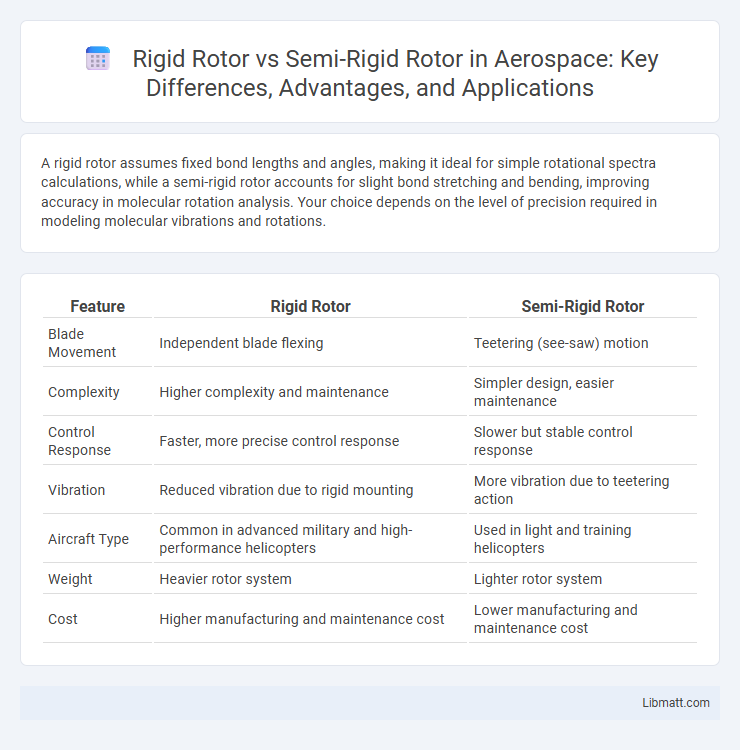A rigid rotor assumes fixed bond lengths and angles, making it ideal for simple rotational spectra calculations, while a semi-rigid rotor accounts for slight bond stretching and bending, improving accuracy in molecular rotation analysis. Your choice depends on the level of precision required in modeling molecular vibrations and rotations.
Table of Comparison
| Feature | Rigid Rotor | Semi-Rigid Rotor |
|---|---|---|
| Blade Movement | Independent blade flexing | Teetering (see-saw) motion |
| Complexity | Higher complexity and maintenance | Simpler design, easier maintenance |
| Control Response | Faster, more precise control response | Slower but stable control response |
| Vibration | Reduced vibration due to rigid mounting | More vibration due to teetering action |
| Aircraft Type | Common in advanced military and high-performance helicopters | Used in light and training helicopters |
| Weight | Heavier rotor system | Lighter rotor system |
| Cost | Higher manufacturing and maintenance cost | Lower manufacturing and maintenance cost |
Introduction to Molecular Rotors
Molecular rotors describe molecules exhibiting rotational motion around specific axes, critical in spectroscopic analysis. A rigid rotor assumes fixed bond lengths and angles, simplifying rotational energy calculations, while a semi-rigid rotor allows minor bond stretching and bending, providing a more accurate model for real molecules. Understanding these differences enhances your interpretation of rotational spectra and molecular dynamics in physical chemistry.
Defining Rigid Rotors
Rigid rotors are molecular models where the bond lengths and angles remain fixed during rotation, ideal for simplifying rotational spectra analysis. In contrast, semi-rigid rotors allow slight variations in bond lengths or angles due to vibration-rotation interaction, affecting moment of inertia calculations. Your understanding of rigid rotors is essential for accurately interpreting rotational spectroscopy and molecular rotational constants.
Overview of Semi-Rigid Rotors
Semi-rigid rotors consist of two blades rigidly attached to a central hub, allowing the blades to flap but restricting lead-lag motion, providing a balance between stability and maneuverability. They are commonly used in smaller helicopters due to their simpler design and reduced maintenance requirements compared to fully articulated rotors. Your choice of rotor system impacts flight dynamics, with semi-rigid rotors offering enhanced control responsiveness and lower mechanical complexity.
Theoretical Foundations: Quantum Mechanics of Rotors
Quantum mechanics describes rigid rotors as idealized molecules with fixed bond lengths, allowing only rotational energy level quantization based on angular momentum. Semi-rigid rotors extend this model by incorporating small bond length vibrations, introducing centrifugal distortion corrections to rotational spectra. Understanding these distinctions sharpens your analysis of molecular rotational spectra and their quantum mechanical foundations.
Key Differences: Rigid vs Semi-Rigid Rotors
Rigid rotors maintain a fixed blade pitch with blades mounted solidly to the hub, providing consistent aerodynamic forces and simpler mechanical design, while semi-rigid rotors allow blades to flap and feather about a teetering hinge to accommodate aerodynamic and inertial loads. The rigid rotor's fixed pitch results in less vibration but limits maneuverability, whereas the semi-rigid rotor's teetering hinge enhances stability and reduces stress during flight maneuvers. Key differences include mechanical complexity, vibration characteristics, and the rotor system's response to aerodynamic forces influencing helicopter handling and maintenance requirements.
Energy Level Structure Comparison
The energy level structure of a rigid rotor is characterized by evenly spaced rotational energy levels determined solely by the rigid moment of inertia, leading to simple quantized rotational transitions. In contrast, a semi-rigid rotor accounts for slight bond length variations during rotation, introducing centrifugal distortion corrections that cause deviations from uniform spacing in the energy levels. Understanding these differences in energy level patterns helps you accurately analyze and predict rotational spectra for various molecular systems.
Spectroscopic Implications
Spectroscopic analysis of rigid rotors reveals sharp, well-defined rotational lines due to fixed bond lengths, enabling precise determination of rotational constants. Semi-rigid rotors exhibit slight bond length variations during rotation, causing perturbations and centrifugal distortion effects that broaden and shift spectral lines. These differences impact the accuracy and interpretation of molecular rotational spectra in high-resolution spectroscopy studies.
Applications in Molecular Spectroscopy
Rigid rotors serve as an idealized model in molecular spectroscopy for analyzing rotational spectra of diatomic and linear molecules, enabling precise determination of rotational constants and bond lengths. Semi-rigid rotors, incorporating vibrational corrections and centrifugal distortion, provide a more accurate description for asymmetric and polyatomic molecules, improving spectral line predictions in high-resolution microwave and infrared spectroscopy. These models assist in elucidating molecular structure, rotational energy levels, and dynamic behavior under various spectroscopic techniques.
Advantages and Limitations of Each Model
The rigid rotor model simplifies molecular rotation by assuming fixed bond lengths and angles, offering computational efficiency and ease of analysis for diatomic and symmetric top molecules but failing to account for vibrational effects and molecular flexibility. The semi-rigid rotor model improves accuracy by allowing slight bond length variations during rotation, capturing centrifugal distortion and enabling better spectral predictions for molecules with moderate flexibility, though it remains less precise for highly anharmonic or large-amplitude motions. Each model balances computational complexity with the level of physical realism required, making the rigid rotor suitable for initial approximations and the semi-rigid rotor preferable for more detailed rotational-vibrational spectroscopy studies.
Summary and Future Perspectives
Rigid rotors exhibit fixed bond lengths and angles, enabling simplified rotational spectroscopy models crucial for molecular structure analysis. Semi-rigid rotors incorporate small vibrational corrections, offering more accurate representations of molecular behavior under varying energy states. Future research aims to integrate advanced computational methods and high-resolution spectroscopy to better understand molecular dynamics and improve predictive accuracy in complex chemical systems.
rigid rotor vs semi-rigid rotor Infographic

 libmatt.com
libmatt.com